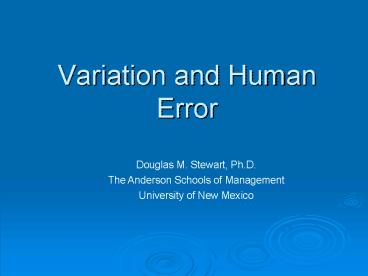Variation and Human Error - PowerPoint PPT Presentation
1 / 13
Title:
Variation and Human Error
Description:
De-coupling the system, Auto-correct features. Reversible and soft boundaries ... Detected by Self. Detected by others. Source Inspection. Self-Checks ... – PowerPoint PPT presentation
Number of Views:84
Avg rating:3.0/5.0
Title: Variation and Human Error
1
Variation and Human Error
Douglas M. Stewart, Ph.D. The Anderson Schools of
Management University of New Mexico
2
Understanding Human Error
- Mistakes vs. Action Slips
- Intention vs. action
- Skill-based activities
- Poka-yokes address action slips
- Action Slips
- Norman (1981) - Activation Trigger Schemata (ATS)
- Reason and Mycielska (1982) - Cognitive Demons
- Sources of Slips (Norman)
- Faulty activation
- Faulty triggering
3
Understanding Human Error (cont.)
- Six common mechanisms (Reason 1990)
- Double capture slips
- Reduced intentionality
- Perceptual confusion
- Interference errors
- Omissions following interruptions
- Mistimed checks (omissions, repetitions and
reversals) - Addressing Mistakes
- Skill Rule Knowledge framework (SRK)
- (Rasmussen 1983, 1987)
- Generic Error Modeling System (GEMS)
- (Reason 1987, 1990)
4
Generic Error Modeling System
1
Adapted from Reason, J. Human Error. p. 64.
5
Skill-based GEMS Mechanisms
- (seen above in action slips)
- Inattention
- Double-capture slips
- Omission following interruptions
- Reduced intentionality
- Perceptual confusion
- Interference errors
- Over Attention
- Omissions
- Repetitions
- Reversals
6
Rule-based GEMS Mechanisms
- General Contributing factors to Rule-based
errors - Information overload
- (signs, countersigns, and non-signs)
- Rule strength
- Rule-based error forms
- Distorted Interpretations
- Frequency and Generality
- Availability (Redundancy)
- Selectivity
- Matching bias (including First exception)
- Communications Fault
- Oversimplification
- Single ordering preference
- Insufficient consideration of process in time
- Difficulties with exponential developments
7
Rule-based GEMS Mechanisms (cont.)
- Conservation of mental effort
- Rigidity (Mind set)
- Overconfidence
- Problems with cause and effect
- Spurious Correlations
- Feedback delay
- Other encoding deficiencies
- Incomplete coding of problem set
- Complex task not yet fully learned
- Action deficiencies
- Bad Rules
8
Knowledge-based GEMS Mechanisms
- Limitations in Cognitive Capabilities
- Workspace limitations
- Out of sight out of mind
- Biased reviewing
- Thinking in causal series not causal nets
- Thematic vagabonding
- Encysting
9
How Mistake-Proofing Works
10
How Mistake-Proofing Works (cont.)
- Three Mistake-Proofing Strategies
- Mistake detection and correction
- Action based
- Outcome based (warning poka-yokes)
- Limiting functions (control poka-yokes)
- Alter the environmental inputs
- POET
- Real World Mapping
- Visibility
- Natural and artificial constraints
- Standards
- Ecological Interface Design
- Error tolerant systems
- De-coupling the system, Auto-correct features
- Reversible and soft boundaries
- Systems that degrade gracefully
11
Conflict between SPC and Poka-Yoke
- Despite the wide acceptance of poka-yoke by
practitioners, academic research is limited. - Reasons
- SPC has more history
- Lack of theoretical basis for poka-yoke
- (Why does it work?)
- SPC and poka-yoke are viewed as substitutes
- (Variation paradigm leads to a rejection of
poka-yoke methods) - Solution
- Theory - Psychology of human error.
- SPC and poka-yoke are complements.
12
Variation and Mistakes
- Seeking support from overlaps in the literature
and reconciling competing concepts - First Order Causes of Defects - Variation and
Mistakes - Require different approaches
- Shingo as originator of ambiguity
- Origins of ideas (SPC just counts defects)
- Poka-yoke examples to control defects from
variation - Machine mistakes
- Variation and discrete events
- Second Order Causes of Defects
- Causes of mistakes and variation
- Complexity (Hinckley and Barkan)
- Culture
13
- Cultural Improvement
- Driving out fear
- Incentives
- Feedback
- Priorities
Culture
Complexity
- Mistake Prevention in the Work Environment
(Complexity Reduction) - Design for Assembly
- Visible System Dynamics
- Use of Standards
- Ecological Interface Design
- Workload balance
- Highlight Important Cues
- Information Poka-yokes
- Simplified Task Structures
- Facilitate Correction
Mistakes
Mistake and Defect Detection
Forcing Function (Control)
Physical Grouping and Counting Sequencing Info
rmation
- Preventing the Influence of Mistakes
- De-couple the System
- Facilitate Correction
Source Inspection Self-Checks Successive
Checks Joint Inspection
Outcome-Based (Warning)
Detected by Self
Detected by others
Variation
- Variation Reduction
- Design for Manufacturing
- Robust Design
- Design of Experiments
- SPC - Identify Special Causes
- Variation Control
- SPC
- Process capability
- Source Inspection Poka-yokes
First Order (Primary) Causes of Defects
Second Order Causes of Defects































